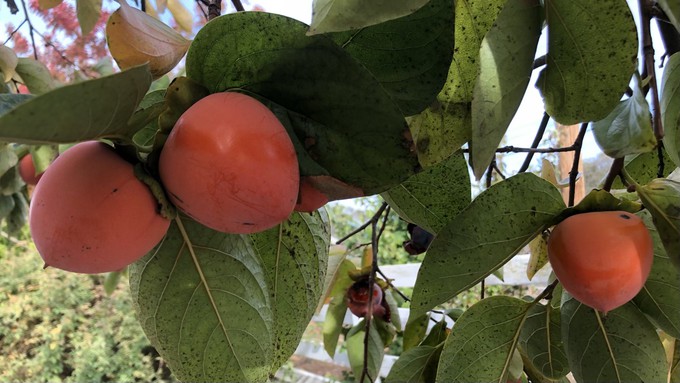
Prepare for frost with these handy tips

Harvest ripe fall fruit, such as persimmons, that may be damaged by frost. Kathy Morrison
After a very warm October, we’re now shivering at night.
It may seem extra early, but frost is in the forecast for the next several nights – especially in the foothills. Downtown Sacramento is expected to see overnight lows dipping into the low 30s.
It’s a shock to our systems – and our plants, too. October averaged afternoon highs of almost 83 degrees – four degrees above normal. Three weeks ago, we were still seeing days in the high 80s.
Storms earlier this week dropped 0.97 inches on Sacramento – and kept overnight temperatures in the upper 40s. But with clear skies come cold nights. According to the National Weather Service, Sacramento can expect lows in the 30s all next week with frost warnings early Monday and Tuesday.
In several recent years, Sacramento’s first frost hasn’t hit until mid- to late December. But historically, frost can bite us any time between early November and the first day of spring. In 2020, we had our first frost warning Nov. 10, although actual freezing temperatures didn’t hit until two weeks later.
Like any challenge, it’s best to be prepared. Have your frost cloths handy and be ready to bundle up your garden when the forecast predicts 32 degrees or colder. Especially at risk are new transplants.
Keep these frost tips handy, too:
* If there is a frost warning, cover your sensitive plants with frost cloth, blankets or cloth sheets (not plastic) before sunset so radiant heat will help keep them cozy.
* Remember to uncover plants during the day (especially if it’s sunny) or they can be smothered by their frost protection.
* Harvest ripe fruit that may be harmed by frost. Don't let pomegranates and persimmons freeze on the tree. The same goes for early citrus such as lemons, limes or mandarins.
* Citrus trees (particularly young trees) tend to be susceptible to frost damage. Limes are the most frost tender. Make sure they get some protection before frost hits.
* Wrap trunks of young citrus trees to insulate them from frost.
* Holiday lights – the old-fashioned kind that get hot, not LEDs – can help keep plants warm, too. Wrap a string of lights around the trunk and branches. Keep the lights on all night.
* With some exceptions, keep plants watered. Frost injury occurs when ice crystals form on leaf surfaces and draw moisture out of the leaf. The damage from dehydration is what causes frost burn.
* The exemption to this rule are cacti and succulents, where saturation can cause more damage. Also, such tropical plants as bananas and hibiscus may rot if over-saturated before frost, so they prefer to be kept on the dry side.
* Don’t overprotect. Plants are more frost resistant if they’ve experienced some cold weather and winter hardening.
* If frost damage occurs, wait until March or April to prune off browned branches. That injured area will help protect the rest of the plant from further frost burn.
Comments
0 comments have been posted.Sacramento Digs Gardening to your inbox.
Sites We Like
Garden Checklist for week of May 5
Survey your garden after the May 4 rainstorm. Heavy rain and gusty winds can break the neck of large flowers such as roses. Also:
* Keep an eye on new transplants or seedlings; they could take a pounding from the rain.
* Watch out for powdery mildew. Warmth following moist conditions can cause this fungal disease to “bloom,” too. If you see a leaf that looks like it’s dusted with powdered sugar, snip it off.
* After the storm, start setting out tomato transplants, but wait on the peppers and eggplants (they want warmer nights). Pinch off any flowers on new transplants to make them concentrate on establishing roots instead of setting premature fruit.
* Trim dead flowers but not leaves from spring-flowering bulbs such as daffodils and tulips. Those leaves gather energy to create next year's flowers. Also, give the bulbs a fertilizer boost after bloom.
* Pinch chrysanthemums back to 12 inches for fall flowers. Cut old stems to the ground.
* Mulch around plants to conserve moisture and control weeds.
* From seed, plant beans, beets, cantaloupes, carrots, corn, cucumbers, melons, pumpkins, radishes and squash.
* Plant onion sets.
* In the flower garden, plant seeds for asters, cosmos, celosia, marigolds, salvia, sunflowers and zinnias. Transplant petunias, zinnias, geraniums and other summer bloomers.
* Plant perennials and dahlia tubers for summer bloom.
* Don’t wait; plant summer bulbs, such as gladiolus and tuberous begonias.
* Harvest cabbage, lettuce, peas and green onions.